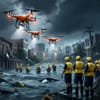Drones equipped with artificial intelligence (AI) have shown promise in search-and-rescue operations, particularly in analyzing drone images to rapidly determine building and road damage after natural disasters. However, finding missing flood victims proves to be a unique challenge. Robotics researchers who study the use of drones in disasters highlight that current AI implementations fall short in this area.
The main issue lies in the visual indicators of flood victims, which differ significantly from those of lost hikers or fugitives. Flood victims are often obscured, camouflaged, entangled in debris, or submerged in water, making it difficult for existing classifiers to detect them accurately. Moreover, machine learning requires training data, but there are no datasets of aerial imagery featuring humans tangled in debris, covered in mud, and not in normal postures, further increasing the possibility of errors in classification.
Despite these challenges, AI can still play a role in searching for flood victims when combined with human expertise. A classifier can help prioritize areas of interest by identifying clumps of debris big enough to contain remains or spotting instances of human activity. This collaboration enables search-and-rescue teams to narrow down and prioritize imagery for further inspection, ultimately enhancing the efficiency of their efforts.
The ideal solution would be an AI system that scans entire images, prioritizes those with the strongest signs of victims, and highlights areas for responders to inspect. However, modern systems have high error rates, and if programmed to overestimate candidate locations, they may produce too many false candidates, overloading search-and-rescue teams.
In the absence of perfect AI solutions, human-AI collaboration remains the most effective approach. By leveraging AI's speed and human judgment, search-and-rescue teams can cover more ground efficiently and effectively, increasing the chances of finding survivors in the critical first hours after a flood.


